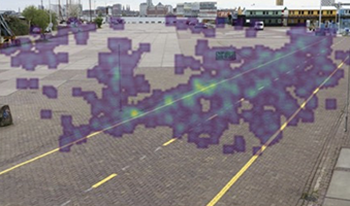References
1AbramsR. A.ChristS. E.2003Motion onset captures attentionPsychol. Sci.14427432427–3210.1111/1467-9280.01458
2
3AndriessenJ. J.BoumaH.1976Eccentric vision: Adverse interactions between line segementsVis. Res.16717871–810.1016/0042-6989(76)90078-X
4
5BehrensR. R.1987The art of dazzle camouflageDefense Analysis3233243233–4310.1080/07430178708405303
6BeintemaJ. A.ToetA.de VriesS. J.2011Conspicuity of moving soldiersProc. SPIE801480140310.1117/12.884241
7BenjaminiY.HochbergY.1995Controlling the false discovery rate: A practical and powerful approach to multiple testingJ. R. Statist. Soc. B57289300289–30010.1111/j.2517-6161.1995.tb02031.x
8BoumaH.1970Interaction effects in parafoveal letter recognitionNature226177178177–810.1038/226177a0
9BrunyéT. T.MartisS.B.HornerC.KirejczykJ.A.RockK.2018Visual salience and biological motion interact to determine camouflaged target detectabilityAppl. Ergon.73161–610.1016/j.apergo.2018.05.016
10BrunyéT. T.MartisS.B.KirejczykJ.A.RockK.2019Camouflage pattern features interact with movement speed to determine human target detectabilityAppl. Ergon.77505750–710.1016/j.apergo.2019.01.004
11BushV.ConantJ.HarrisonG. B.Camouflage of Sea-search Aircraft1946Office of Scientific Research and Development, National Defence Research CommitteeCollege Park, MD
12CassJ.Van der BurgE.AlaisD.2011Finding flicker: Critical differences in temporal frequency capture attentionFrontiers in Perception Science2171–710.3389/fpsyg.2011.00320
13CovertC. T.2007Art at war: Dazzle camouflageArt Documentation: J. Art Libraries Society of North America26505650–610.1086/adx.26.2.27949469
14CuthillI. C.StevensM.SheppardJ.MaddocksT.PárragaC. A.TrosciankoT. S.2005Disruptive coloration and background pattern matchingNature434727472–410.1038/nature03312
15CzuldaR.Visual signature management systems from PolandMilitary Technology (Summer 2015)2015Vol. 45Mönch Verlagsgesellschaft mbHBad Neuenahr-Ahrweiler, Germany
16DenningR. J.
17DuncanJ.HumphreysG. W.1989Visual search and stimulus similarityPsychol. Rev.96433458433–5810.1037/0033-295X.96.3.433
18DuncanJ.HumphreysG. W.1992Beyond the search surface: Visual search and attentional engagementJ. Exp. Psychol. Human Perception and Performance18578588578–8810.1037/0096-1523.18.2.578
19HallJ. R.CuthillI. C.BaddeleyR.ShohetA. J.Scott-SamuelN. E.
20HallJ. R.CuthillI. C.BaddeleyR.AttwoodA. S.MunafM. R.Scott-SamuelN. E.2016Dynamic dazzle distorts speed perceptionPLoS One11e015516210.1371/journal.pone.0155162
21HanlonR. T.ChiaoC.-C.MäthgerL. M.BarbosaA.BureschK. C.ChubbC.2008Cephalopod dynamic camouflage: bridging the continuum between background matching and disruptive colorationPhil. Trans. R. Soc. B364429437429–3710.1098/rstb.2008.0270
22HoganB. G.CuthillI.C.Scott-SamuelN. E.2016Dazzle camouflage, target tracking, and the confusion effectBehav. Ecol.27154715511547–5110.1093/beheco/arw081
23HoganB. G.CuthillI. C.Scott-SamualN. E.2017Dazzle camouflage and the confusion effect: the influence of varying speed on target trackingAnimal Behaviour123349353349–5310.1016/j.anbehav.2016.11.022
24HogervorstM. A.BijlP.ToetA.2005On the relationship between human search strategies, conspicuity, and search performanceProc. SPIE578410.1117/12.602486
25HogervorstM. A.ToetA.JacobsP. A. M.2010Design and evaluation of (urban) camouflageProc. SPIE766276620510.1117/12.850423
26HughesA. E.JonesC.JoshiK.TolhurstD. J.2017Diverted by dazzle: perceived movement direction is biased by target pattern orientationProc. R. Soc. B2842017001510.1098/rspb.2017.0015
27JacobsP. A. M.van BreemenA.HogervorstM.Adaptive Camouflage Technologies Project: ACT/Cameleon Report TNO-DV 2011 A012, TNO2011TNO Netherlands Organization for Applied Scientific ResearchThe Hague, The Netherlands
28
29JohanssonG.1973Visual perception of biological motion and a model for its analysisPerception Psychophysics14201211201–1110.3758/BF03212378
30JosefN.AmodioP.FioritoG.ShasharN.2012Camouflaging in a complex environment–Octopuses use specific features of their surroundings for background matchingPLoS One7e3757910.1371/journal.pone.0037579
31JosefN.BerenshteinI.FioritoG.SykesA. V.ShasharN.2015Camouflage during movement in the European cuttlefish (Sepia officinalis)J. Exp. Biol.218339133983391–810.1242/jeb.122481
32KongG.AlaisD.Van der BurgE.2016An investigation of linear separability in visual search for color suggests a role of recognizabilityJ. Exp. Psychol. Human Perception and Performance42172417381724–3810.1037/xhp0000249
33KongG.AlaisD.Van der BurgE.2016Competing distractors facilitate visual search in heterogeneous displaysPLoS One11e016091410.1371/journal.pone.0160914
34LeviD. M.ToetA.TripathyS. P.KooiF. L.1994The effect of similarity and duration on spatial interaction in peripheral visionSpatial Vis.8255279255–7910.1163/156856894X00350
35KooiF. L.ToetA.1999Conspicuity: An effect alternative for search timeVis. Vehicles7451462451–62
36KorteW.
37MélyD. A.KimJ. McGillM.GuoY.SerreabT.2016A systematic comparison between visual cues for boundary detectionVis. Res.1209310793–10710.1016/j.visres.2015.11.007
38MerilaitaS.StevensM.Crypsis Through Background Matching2011Cambridge University PressCambridge
39MerilaitaS.Scott-SamuelN. E.CuthillI. C.2017How camouflage worksPhil. Trans. R. Soc. B37210.1098/rstb.2016.0341
40NeriP.MorroneM. C.BurrD.1998Seeing biological motionNature395894896894–610.1038/27661
41OwensA.BarnesC.FlintA.SinghH.FreemanW.
42PalmerE. M.HorowitzT. S.TorralbaA.WolfeJ. M.2011What are the shapes of response time distributions in visual search?J. Exp. Psychol. Human Perception Performance375810.1037/a0020747
43PeirceJ.GrayJ. R.SimpsonS.MacAskillM.HöchenbergerR.SogoH.KastmanE.LindeløvJ. K.2019PsychoPy2: Experiments in behavior made easyBehavior Res. Methods51195203195–20310.3758/s13428-018-01193-y
44SchaeferH. M.StobbeN.2006Disruptive coloration provides camouflage independent of background matchingProc. R. Soc. B273242724322427–3210.1098/rspb.2006.3615
45SmartI. E.CuthillI. C.Scott-SamuelN. E.2020In the corner of the eye: camouflaging motion in the peripheral visual fieldProc. R. Soc. B2872019253710.1098/rspb.2019.2537
46SmithK. C.AbramsR. A.2018Motion onset really does capture attentionAttention, Perception, Psychophysics80177517841775–8410.3758/s13414-018-1548-1
47StevensM.2007Predator perception and the interrelation between different forms of protective colorationProc. R. Soc. B274145714641457–6410.1098/rspb.2007.0220
48StevensM.MerilaitaS.2009Animal camouflage: current issues and new perspectivesPhil. Trans. R. Soc. B364423427423–710.1098/rstb.2008.0217
49ThayerA. H.CamouflageThe Scientific Monthly1918Vol. 7American Association for the Advancement of Science481494481–94
50TheeuwesJ.Van der BurgE.2007The role of spatial and non-spatial information in visual searchJ. Exp. Psychol. Human Perception and Performance33133513511335–5110.1037/0096-1523.33.6.1335
51TurattoM.GalfanoG.2000Color, form and luminance capture attention in visual searchVis. Res.40163916431639–4310.1016/S0042-6989(00)00061-4
52UmetonD.ReadJ. C. A.RoeweC.2017Unravelling the illusion of flicker fusionBiol. Lett.132016083110.1098/rsbl.2016.0831
53Van der BurgE.OliversC. N.BronkhorstA. W.TheeuwesJ.2008Pip and pop: Non-spatial auditory signals improve spatial visual searchJ. Exp. Psychol. Human Perception and Performance34105310651053–6510.1037/0096-1523.34.5.1053
54Van der BurgE.OliversC. N.BronkhorstA. W.TheeuwesJ.2009Poke and pop: Tactile-visual synchrony increases visual saliencyNeurosci. Lett.450606460–410.1016/j.neulet.2008.11.002
55Van der BurgE.CassJ.OliversC. N.TheeuwesJ.AlaisD.2010Efficient visual search from synchronized auditory signals requires transient audiovisual eventsPLoS One5e1066410.1371/journal.pone.0010664
56Van der BurgE.OliversC. N.CassJ.2017Evolving the keys to visual crowdingJ. Exp. Psychol. Human Perception and Performance43690699690–910.1037/xhp0000337
57Van der BurgE.ReynoldsA.CassJ.OliversC. N.Visual crowding does not scale with eccentricity for densely cluttered displaysPerception2019Sage publications LTDEngland272727–
58Van der BurgE.CassJ.TheeuwesJ.2019Changes (but not differences) in motion direction fail to capture attentionVis. Res.165546354–6310.1016/j.visres.2019.09.008
59WallisT. S. A.BexP. J.
60WolfeJ. M.HorowitzT. S.2004What attributes guide the deployment of visual attention and how do they do it?Nature Rev. Neurosci.5171–710.1038/nrn1411
61XuC.StiubianuG. T.GorodetskyA. A.2018Adaptive infrared-reflecting systems inspired by cephalopodsScience359149515001495–50010.1126/science.aar5191

 Find this author on Google Scholar
Find this author on Google Scholar Find this author on PubMed
Find this author on PubMed